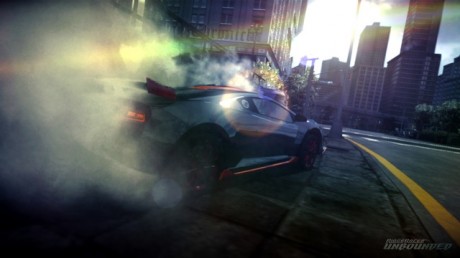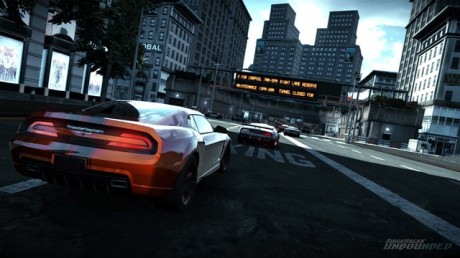We take a look at destruction-centric Unbounded, the start of a “new branch” for the Ridge Racer series.

You have to squint to see a Ridge Racer game in Ridge Racer: Unbounded. It looks, in many ways, closer to any number of racing titles built around violent takedowns and environmental destruction. The way producer Joonas Laakso tells it, Unbounded is the product of his racing specialist studio, Bugbear Entertainment, being tasked with bringing its technology to bear on a “new branch” of the Ridge Racer series–that is, racing damage and physics technology grown out of making the demolition-focused FlatOut games. “We are really good at smashing things up,” he says.
Bugbear has matched that destructibility tech with Ridge Racer “intensity”, says Laakso, in the fictional East Coast city of Shatter Bay, where illegal racers (the titular Unbounded) battle to dominate the streets. The city, inspired by New York and Chicago, is designed for “carnage and risk-taking”; built for dynamic, piece-by-piece, physics-based destruction rather than scripted spectacle that is the same each time it’s triggered. (Laakso admires Split/Second but says that unpredictable, procedural destruction gives Unbounded the edge over it.)
The driving experience itself takes drifting and boosting from its Ridge Racer heritage–otherwise, says Laakso, nothing has been brought over wholesale from earlier Ridge Racer games, except for some classic cars. We are shown Crash Race mode, in which you charge up your destruction power with drifting, chasing other drivers, and post-jump airtime (other modes will be more purely about crashing, and others more purely about racing). With this power charged, you’ll see markers thrown up on certain buildings and obstacles, indicating a target in need of your destructive attention. Unbounded, then, has unscripted but not universal destruction–there are certain spots designed specifically for taking dynamic damage.
The first target we see lets you drive through a bank’s front doors, smashing your way to a set of windows in the back, out of which you come soaring, ahead of your opponents–and opening up the shortcut for future use. Later in the race, a target lets you drive through a bridge support, bringing the bridge crashing down on racers behind you. To ‘dominate’ a track, you have to find and activate all dozen or so targets available. The demolition of targets isn’t as flashy or cinematic as in Split/Second, for example, but seems more natural and involving for being generated on the fly.
Beside large-scale targeted demolition, Unbounded offers smaller things to smash. Anything smaller and lighter than your car, says Laakso, is fair game for crashing into and through, with only cosmetic damage resulting to your vehicle and no impact on your driving. You’ll get more points for taking out rivals into collateral, though, ramming them into obstacles. In this case, your opponent’s car damage is more than cosmetic–and also dynamic rather than pre-set.

Your points score might be shown projected in the game world, but it might not; the game decides on the most relevant or interesting scrap of information to feed you, and integrates it into the game world (overlaid on a roadside barrier in huge white letters, for instance) as you zoom past, like an augmented reality billboard. In the demo we see, there’s no traditional HUD interface to speak of, and the producer confirms that Bugbear is aiming for as minimal a HUD as possible in the finished game.
All the game environments will be urban, so there are no countryside drives in store, with the city divided into smaller districts; Shatter Bay has “dozens” of tracks in the single-player mode. Laakso hints heavily that the game will feature “thousands” of cities, however, suggesting that the multiplayer portion will take you far beyond Shatter Bay. Could the offering of that many distinct cities in an online multiplayer mode imply creation tools for users to make and share maps and tracks online? We’ll know more come this year’s Electronic Entertainment Expo in June.